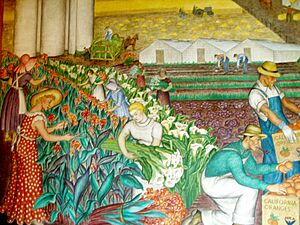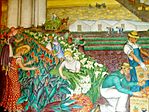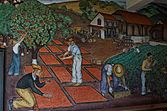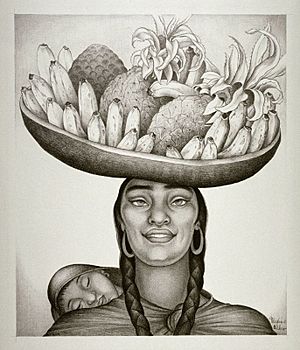Maxine Albro facts for kids
Quick facts for kids
Maxine Albro
|
|
|---|---|
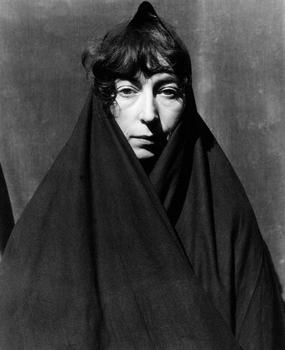
Maxine Albro, photographed by Imogen Cunningham in 1931
|
|
| Born | 20 January 1893 Ayrshire, Iowa, US
|
| Died | 19 July 1966 (aged 73) Los Angeles, California, US
|
| Known for | Painting, Mural, Lithography, Mosaic, Sculpture |
Maxine Albro (born January 20, 1893 – died July 19, 1966) was an American artist. She was a painter, muralist (someone who paints large wall art), lithographer (who makes prints), mosaic artist, and sculptor. Maxine was one of the most important female artists in America. She was also one of the few women chosen to create art for a special government program called the Federal Art Project. This program was part of the New Deal, which helped people find jobs during a tough time in history.
Contents
About Maxine Albro
Maxine Albro was born Ethel Maxine Albro in 1893 in Ayrshire, Iowa. Her father, Frank Albro, sold grain and pianos, and her mother was Cordelia Mead. Maxine had two brothers, Francis and Harold. She spent some of her childhood in Estherville, Iowa, and later grew up in Los Angeles.
A famous photographer named Imogen Cunningham took a special picture of Maxine in 1931. This photo was part of a collection that included other well-known artists like Frida Kahlo.
In 1938, Maxine married another artist named Parker Hall in Pima, Arizona. They moved to Carmel, California, and often traveled to Mexico together.
Maxine was a member of several art groups, including the American Artists' Congress and the California Art Club. She passed away in Los Angeles in 1966 when she was 73 years old.
Her Art Career
In 1920, after finishing high school, Maxine moved to San Francisco and worked as a commercial artist. She then traveled to Paris, France, to study art for a year at the Académie de la Grande Chaumière. When she returned, she continued her studies at the California School of Fine Arts from 1923 to 1925. Later, she also studied at the Art Students League of New York.
In 1927, Maxine visited Mexico for the first time. There, she learned about fresco painting (a way of painting on wet plaster) from Pablo O'Higgins, who worked with the famous artist Diego Rivera. Maxine even got to meet Diego Rivera himself!
Starting in 1925, Maxine showed her art at the annual San Francisco Art Association show. She became known as "a little Diego Rivera" because of her style. This led to many private art jobs in 1929 and 1930, including a fresco called Spanish Farm for the Allied Arts Guild in Menlo Park, California.
In 1931, Maxine had a big art show in New York City. Her show featured 30 paintings and 30 drawings, and it was a huge success with both art critics and the public.
Art for the Public
Maxine Albro was one of the few women artists who worked for the Works Progress Administration's Federal Art Project. This was a government program started by President Franklin Roosevelt during the Great Depression. Because many people were jobless, these art programs made sure to hire female artists. This was a big step, as it was one of the first times women were hired for art jobs without being treated unfairly in the United States.
Her first big project for this program was painting one of the murals at Coit Tower in San Francisco. She even traded her original wall with another artist, Victor Arnautoff, to get the perfect spot.
Throughout the 1930s, Maxine completed many projects for the government. One of these was a mosaic (a picture made from small pieces of colored stone or glass) at San Francisco State Teacher's College in 1936. None of the artists working on this mosaic had ever made one before. So, the program hired an Italian mosaic expert to teach them how to break marble and create the mosaic pieces.
Besides public art, Maxine also painted frescoes for many private homes. This included the entrance and courtyard of the Seldon Williams House in Berkeley, California, which was designed by famous architect Julia Morgan.
Maxine's Artistic Style
Maxine Albro's art style is described as "clean, bright, and clear." She often used strong, rounded shapes in her work. She frequently painted women from Mexico, especially from the Tehuantepec region in Oaxaca.
Her mural called California at San Francisco's Coit Tower shows the rich farm products of California. This mural was created as part of the Works Progress Administration program.
Who Influenced Her?
Maxine was best known for her frescoes and for how she painted Mexican and Spanish subjects. You can see the influence of Mexican art in many of her paintings, murals, and lithographs.
She was especially inspired by Diego Rivera. Maxine once said, "Watching Diego [paint] was very beneficial to me," meaning it helped her a lot.
Her Impact and Legacy
Maxine Albro's artworks can be found in many important places, such as the Smithsonian American Art Museum, The Museum of Modern Art (MoMA), the National Gallery of Art, and San Francisco's Coit Tower. Her art is also in various galleries and private collections.
Maxine became a leader in the California muralist movement. She was one of the first women to become so well-known in this field. Her paintings and lithographs are now rare and valuable collector's items. While she often focused on Spanish and Mexican themes, she also painted landscapes and street scenes inspired by her travels around the world.
See also
- Visual art of the United States
- Public Works of Art Project
- Federal Art Project
- List of Federal Art Project artists


